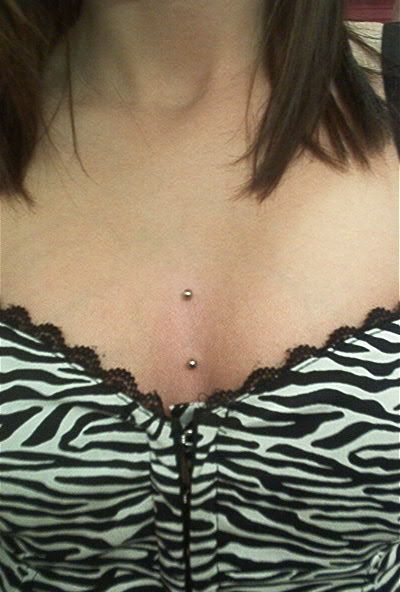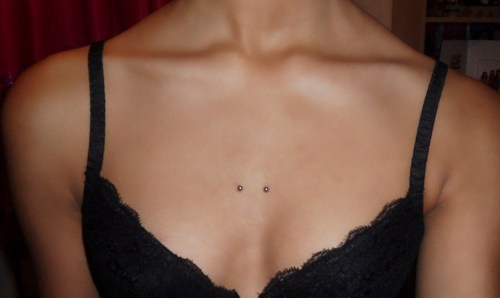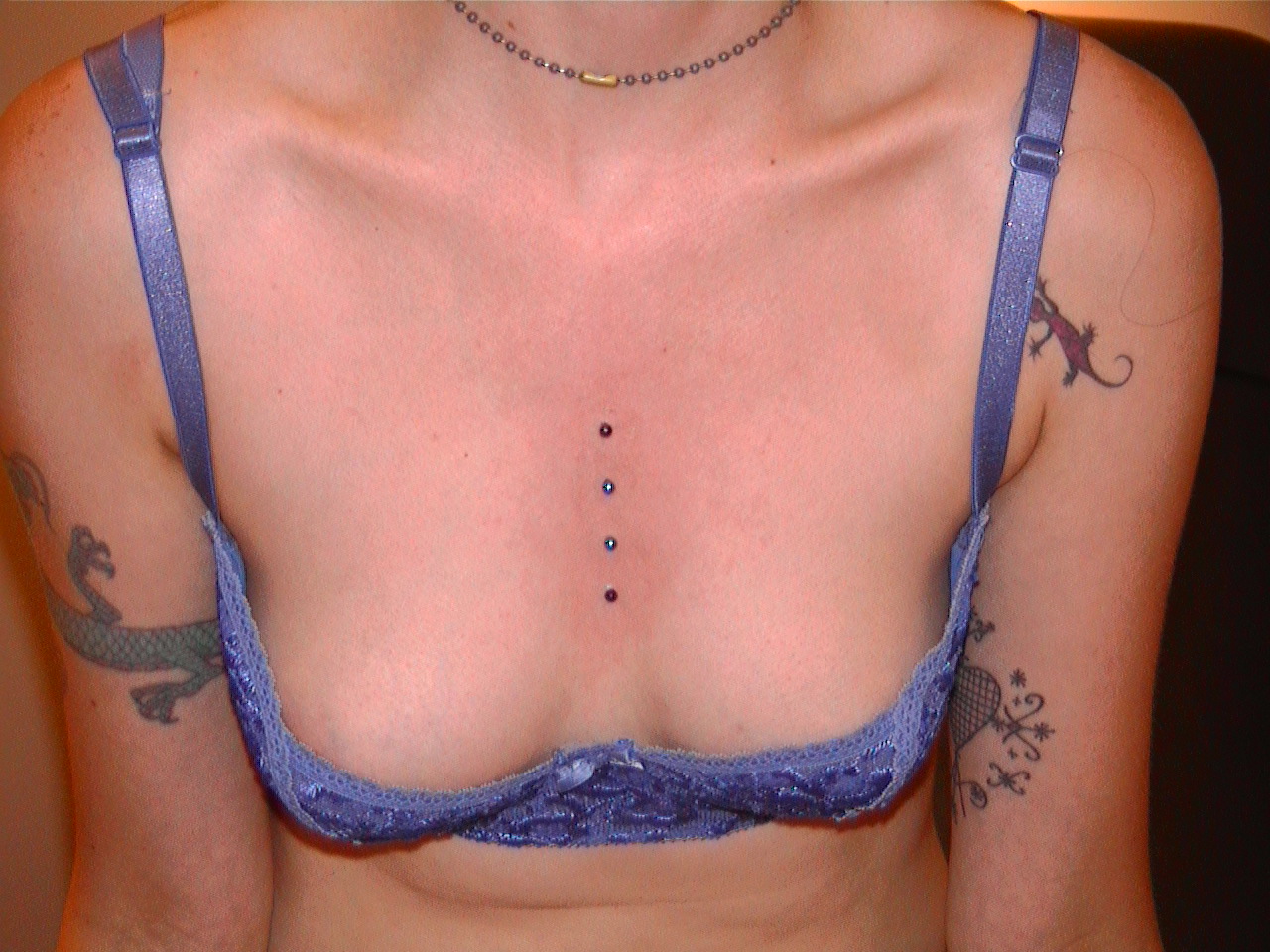Source(google.com.pk)
Cleavage Piercings Biography
A ruby is a pink to blood-red colored gemstone, a variety of the mineral corundum (aluminium oxide). The red color is caused mainly by the presence of the element chromium. Its name comes from ruber, Latin for red. Other varieties of gem-quality corundum are called sapphires. The ruby is considered one of the four precious stones, together with the sapphire, the emerald, and the diamond.[1]
Prices of rubies are primarily determined by color. The brightest and most valuable "red" called pigeon blood-red, commands a large premium over other rubies of similar quality. After color follows clarity: similar to diamonds, a clear stone will command a premium, but a ruby without any needle-like rutile inclusions may indicate that the stone has been treated. Cut and carat (weight) are also an important factor in determining the price.
Rubies have a hardness of 9.0 on the Mohs scale of mineral hardness. Among the natural gems only moissanite and diamond are harder, with diamond having a Mohs hardness of 10.0 and moissonite falling somewhere in between corundum (ruby) and diamond in hardness. Ruby is α-alumina (the most stable form of Al2O3) in which a small fraction of the aluminium3+ ions are replaced by chromium3+ ions. Each Cr3+ is surrounded octahedrally by six O2- ions. This crystallographic arrangement strongly affects each Cr3+, resulting in light absorption in the yellow-green region of the spectrum and thus in the red color of the gem. When yellow-green light is absorbed by Cr3+, it is re-emitted as red luminescence.[2] This red emission adds to the red color perceived by the subtraction of green and violet light from white light, and adds luster to the gem's appearance. When the optical arrangement is such that the emission is stimulated by 694-nanometer photons reflecting back and forth between two mirrors, the emission grows strongly in intensity. This effect was used by Theodore Maiman in 1960 to make the first successful laser, based on ruby.
All natural rubies have imperfections in them, including color impurities and inclusions of rutile needles known as "silk". Gemologists use these needle inclusions found in natural rubies to distinguish them from synthetics, simulants, or substitutes. Usually the rough stone is heated before cutting. Almost all rubies today are treated in some form, with heat treatment being the most common practice. However, rubies that are completely untreated but still of excellent quality command a large premium.
Some rubies show a three-point or six-point asterism or "star". These rubies are cut into cabochons to display the effect properly. Asterisms are best visible with a single-light source, and move across the stone as the light moves or the stone is rotated. Such effects occur when light is reflected off the "silk" (the structurally oriented rutile needle inclusions) in a certain way. This is one example where inclusions increase the value of a gemstone. Furthermore, rubies can show color changes—though this occurs very rarely—as well as chatoyancy or the "cat's eye" effect.
Generally, gemstone-quality corundum in all shades of red, including pink, are called rubies.[3][4] However, in the United States, a minimum color saturation must be met to be called a ruby, otherwise the stone will be called a pink sapphire.[3] This distinction between rubies and pink sapphires is relatively new, having arisen sometime in the 20th century. If a distinction is made, the line separating a ruby from a pink sapphire is not clear and highly debated.[5] As a result of the difficulty and subjectiveness of such distinctions, trade organizations such as the International Colored Gemstone Association (ICGA) have adopted the broader definition for ruby which encompasses its lighter shades, including pink.
The Mogok Valley in Upper Myanmar (Burma) was for centuries the world's main source for rubies. That region has produced some of the finest rubies ever mined, but in recent years very few good rubies have been found there. The very best color in Myanmar rubies is sometimes described as "pigeon's blood." In central Myanmar, the area of Mong Hsu began producing rubies during the 1990s and rapidly became the world's main ruby mining area. The most recently found ruby deposit in Myanmar is in Namya (Namyazeik) located in the northern state of Kachin.
Rubies have historically been mined in Thailand, the Pailin and Samlout District of Cambodia, Burma, India, Afghanistan and in Pakistan. In Sri Lanka, lighter shades of rubies (often "pink sapphires") are more commonly found. After the Second World War ruby deposits were found in Tanzania, Madagascar, Vietnam, Nepal, Tajikistan, and Pakistan.
A few rubies have been found in the U.S. states of Montana, North Carolina, South Carolina and Wyoming. While searching for aluminous schists in Wyoming, geologist Dan Hausel noted an association of vermiculite with ruby and sapphire and located six previously undocumented deposits.[8]
More recently, large ruby deposits have been found under the receding ice shelf of Greenland.
Republic of Macedonia is the only country in mainland Europe to have naturally occurring rubies. They can mainly be found around the city of Prilep. Macedonian ruby has a unique raspberry color.
In 2002 rubies were found in the Waseges River area of Kenya. There are reports of a large deposit of rubies found in 2009 in Mozambique, in Nanhumbir in the Cabo Delgado district of Montepuez.[9]
Spinel, another red gemstone, is sometimes found along with rubies in the same gem gravel or marble. Red spinel may be mistaken for ruby by those lacking experience with gems. However, the finest red spinels can have a value approaching that of the average ruby.[10] The color of rubies varies from vermilion to red. The most desired color is "pigeon's blood", which is pure red with a hint of blue. If the color is too pink, the stone is a pink sapphire. The same is true if it is too violet – it is a violet sapphire. The best rubies and star rubies are bright red. Most rubies come from Burma and Thailand.
Diamonds are graded using criteria that have become known as the four Cs, namely color, cut, clarity and carat weight. Similarly natural rubies can be evaluated using the four Cs together with their size and geographic origin.
Color: In the evaluation of colored gemstones, color is the single most important factor. Color divides into three components; hue, saturation and tone. Hue refers to "color" as we normally use the term. Transparent gemstones occur in the following primary hues: red, orange, yellow, green, blue, violet. These are known as pure spectral hues.[11] In nature there are rarely pure hues so when speaking of the hue of a gemstone we speak of primary and secondary and sometimes tertiary hues. In ruby the primary hue must be red. All other hues of the gem species corundum are called sapphire. Ruby may exhibit a range of secondary hues. Orange, purple, violet and pink are possible.










Cleavage Piercings Biography
A ruby is a pink to blood-red colored gemstone, a variety of the mineral corundum (aluminium oxide). The red color is caused mainly by the presence of the element chromium. Its name comes from ruber, Latin for red. Other varieties of gem-quality corundum are called sapphires. The ruby is considered one of the four precious stones, together with the sapphire, the emerald, and the diamond.[1]
Prices of rubies are primarily determined by color. The brightest and most valuable "red" called pigeon blood-red, commands a large premium over other rubies of similar quality. After color follows clarity: similar to diamonds, a clear stone will command a premium, but a ruby without any needle-like rutile inclusions may indicate that the stone has been treated. Cut and carat (weight) are also an important factor in determining the price.
Rubies have a hardness of 9.0 on the Mohs scale of mineral hardness. Among the natural gems only moissanite and diamond are harder, with diamond having a Mohs hardness of 10.0 and moissonite falling somewhere in between corundum (ruby) and diamond in hardness. Ruby is α-alumina (the most stable form of Al2O3) in which a small fraction of the aluminium3+ ions are replaced by chromium3+ ions. Each Cr3+ is surrounded octahedrally by six O2- ions. This crystallographic arrangement strongly affects each Cr3+, resulting in light absorption in the yellow-green region of the spectrum and thus in the red color of the gem. When yellow-green light is absorbed by Cr3+, it is re-emitted as red luminescence.[2] This red emission adds to the red color perceived by the subtraction of green and violet light from white light, and adds luster to the gem's appearance. When the optical arrangement is such that the emission is stimulated by 694-nanometer photons reflecting back and forth between two mirrors, the emission grows strongly in intensity. This effect was used by Theodore Maiman in 1960 to make the first successful laser, based on ruby.
All natural rubies have imperfections in them, including color impurities and inclusions of rutile needles known as "silk". Gemologists use these needle inclusions found in natural rubies to distinguish them from synthetics, simulants, or substitutes. Usually the rough stone is heated before cutting. Almost all rubies today are treated in some form, with heat treatment being the most common practice. However, rubies that are completely untreated but still of excellent quality command a large premium.
Some rubies show a three-point or six-point asterism or "star". These rubies are cut into cabochons to display the effect properly. Asterisms are best visible with a single-light source, and move across the stone as the light moves or the stone is rotated. Such effects occur when light is reflected off the "silk" (the structurally oriented rutile needle inclusions) in a certain way. This is one example where inclusions increase the value of a gemstone. Furthermore, rubies can show color changes—though this occurs very rarely—as well as chatoyancy or the "cat's eye" effect.
Generally, gemstone-quality corundum in all shades of red, including pink, are called rubies.[3][4] However, in the United States, a minimum color saturation must be met to be called a ruby, otherwise the stone will be called a pink sapphire.[3] This distinction between rubies and pink sapphires is relatively new, having arisen sometime in the 20th century. If a distinction is made, the line separating a ruby from a pink sapphire is not clear and highly debated.[5] As a result of the difficulty and subjectiveness of such distinctions, trade organizations such as the International Colored Gemstone Association (ICGA) have adopted the broader definition for ruby which encompasses its lighter shades, including pink.
The Mogok Valley in Upper Myanmar (Burma) was for centuries the world's main source for rubies. That region has produced some of the finest rubies ever mined, but in recent years very few good rubies have been found there. The very best color in Myanmar rubies is sometimes described as "pigeon's blood." In central Myanmar, the area of Mong Hsu began producing rubies during the 1990s and rapidly became the world's main ruby mining area. The most recently found ruby deposit in Myanmar is in Namya (Namyazeik) located in the northern state of Kachin.
Rubies have historically been mined in Thailand, the Pailin and Samlout District of Cambodia, Burma, India, Afghanistan and in Pakistan. In Sri Lanka, lighter shades of rubies (often "pink sapphires") are more commonly found. After the Second World War ruby deposits were found in Tanzania, Madagascar, Vietnam, Nepal, Tajikistan, and Pakistan.
A few rubies have been found in the U.S. states of Montana, North Carolina, South Carolina and Wyoming. While searching for aluminous schists in Wyoming, geologist Dan Hausel noted an association of vermiculite with ruby and sapphire and located six previously undocumented deposits.[8]
More recently, large ruby deposits have been found under the receding ice shelf of Greenland.
Republic of Macedonia is the only country in mainland Europe to have naturally occurring rubies. They can mainly be found around the city of Prilep. Macedonian ruby has a unique raspberry color.
In 2002 rubies were found in the Waseges River area of Kenya. There are reports of a large deposit of rubies found in 2009 in Mozambique, in Nanhumbir in the Cabo Delgado district of Montepuez.[9]
Spinel, another red gemstone, is sometimes found along with rubies in the same gem gravel or marble. Red spinel may be mistaken for ruby by those lacking experience with gems. However, the finest red spinels can have a value approaching that of the average ruby.[10] The color of rubies varies from vermilion to red. The most desired color is "pigeon's blood", which is pure red with a hint of blue. If the color is too pink, the stone is a pink sapphire. The same is true if it is too violet – it is a violet sapphire. The best rubies and star rubies are bright red. Most rubies come from Burma and Thailand.
Diamonds are graded using criteria that have become known as the four Cs, namely color, cut, clarity and carat weight. Similarly natural rubies can be evaluated using the four Cs together with their size and geographic origin.
Color: In the evaluation of colored gemstones, color is the single most important factor. Color divides into three components; hue, saturation and tone. Hue refers to "color" as we normally use the term. Transparent gemstones occur in the following primary hues: red, orange, yellow, green, blue, violet. These are known as pure spectral hues.[11] In nature there are rarely pure hues so when speaking of the hue of a gemstone we speak of primary and secondary and sometimes tertiary hues. In ruby the primary hue must be red. All other hues of the gem species corundum are called sapphire. Ruby may exhibit a range of secondary hues. Orange, purple, violet and pink are possible.
Cleavage Piercings Photos Pictures Pics Images

Cleavage Piercings Photos Pictures Pics Images

Cleavage Piercings Photos Pictures Pics Images

Cleavage Piercings Photos Pictures Pics Images

Cleavage Piercings Photos Pictures Pics Images

Cleavage Piercings Photos Pictures Pics Images

Cleavage Piercings Photos Pictures Pics Images

Cleavage Piercings Photos Pictures Pics Images

Cleavage Piercings Photos Pictures Pics Images

Cleavage Piercings Photos Pictures Pics Images

Cleavage Piercings Photos Pictures Pics Images